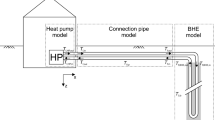Abstract
Foundation heat exchangers (FHXs) are an alternative to more costly ground heat exchangers utilized in ground-source heat pump (GSHP) systems serving detached or semi-detached houses. Simulation models of FHX are needed for design and energy calculations. This paper looks at two approaches used for development of simulation models for FHX systems: a simplified analytical model and a detailed numerical model. The analytical model is based on superposition of line sources and sinks. The numerical model is a two-dimensional finite volume model implemented in the HVACSIM+ environment. Both the analytical and numerical models have been validated again experimental results from a test house located in Oak Ridge, Tennessee. Six geographically diverse locations are chosen for a parametric study; results of the two models are compared, and differences between the results are investigated.
Similar content being viewed by others
References
Antonopoulos VZ (2006). Water movement and heat transfer simulations in a soil under ryegrass. Journal of Biosystems Engineering, 95: 127–138.
Bose JE, Parker JD, McQuiston FC (1985). Design/Data Manual for Closed-Loop Ground Coupled Heat Pump Systems. Atlanta: ASHRAE.
Briggs RS, Lucas RG, Taylor T (2003). Climate classification for building energy codes and standards: Part 1-Development process. ASHRAE Transactions, 109(1): 109–117.
Chang JH (1958). Ground Temperature. Cambridge, MA: Bluehill Meteorological Observatory, Harvard University.
Christian J (2007). A glimpse of the energy future. Oak Ridge National Laboratory Review, 40(2): 2–7.
Collins WD (1925). Temperature of water available for industrial use in the United States. United States Geological Survey Water Supply Paper 520-F, Washington, DC: USGS.
Cullin JR, Spitler JD (2011). A computationally efficient hybrid time step methodology for simulation of ground heat exchangers. Geothermics, 40: 144–156.
Cullin JR, Xing L, Lee E, Fisher DE, Spitler JD (2012). Feasibility of foundation heat exchangers for residential ground surface heat pump systems in the United States. ASHRAE Transactions, 18(1): n. p.
Fan D, Rees SJ, Spitler JD (2011). Application of dynamic thermal networks to the modeling of foundation heat exchangers. In: Proceedings of Building Simulation 2011, Sydney, Australia.
Kusuda T, Achenbach PR (1965). Earth temperature and thermal diffusivity at selected stations in the United States. ASHRAE Transactions, 71(1): 61–76.
Lamberg P, Lehtiniemi R, Henell A-M (2004). Numerical and experimental investigation of melting and freezing processes in phase change material storage. International Journal of Thermal Sciences, 43: 277–287.
Lu S, Ren T, Gong Y, Horton R (2007). An improved model for predicting soil thermal conductivity from water content at room temperature. Soil Science Society of America Journal, 71: 8–14.
Mei VC (1985). Theoretical heat pump ground coil analysis with variable ground farfield boundary conditions. AlChE Symposium Series, 245: 7–12.
Mei VC (1988). Heat pump ground coil analysis with thermal interference. Journal of Solar Energy Engineering, 110: 67–73.
Mei VC, Emerson CJ (1985). New approach for analysis of ground-coil design for applied heat pump systems. ASHRAE Journal, 91: 1216–1224.
Miller W, Kośny J, Shrestha S, Christian J, Karagiozis A, Kohler C, and Dinse D (2010). Advanced residential envelopes for two pair of energy-saver homes. In: Proceedings of ACEEE Summer Study on Energy Efficiency in Buildings, Pacific Grove, CA, USA.
Natural Resources Conservation Service (2011). Web Soil Survey. United States Department of Agriculture. Available online at http://websoilsurvey.nrcs.usda.gov/.
Niu GY, Yang ZL (2006). Effects of frozen soil on snowmelt runoff and soil water storage at a continental scale. Journal of Hydrometeorology, 7: 937–952.
Piechowski M (1998). Heat and mass transfer model of a ground heat exchanger: Validation and sensitivity analysis. International Journal of Energy Research, 22: 965–979.
Piechowski M (1999). Heat and mass transfer model of a ground heat exchanger: Theoretical development. International Journal of Energy Research, 23: 571–588.
Shonder J, Spitler JD (2009). Foundation heat exchangers: Reducing the first cost of ground source heat pumps. IEA Heat Pump Centre Newsletter, 27(1): 22–23.
Spitler JD (2000). A design tool for commercial building ground loop heat exchangers. In: Proceedings of the Fourth International Heat Pumps in Cold Climates Conference, Aylmer, Québec, Canada.
Spitler JD, Xing L, Cullin JR, Fisher DE, Shonder J, and Im P (2010). Residential Ground Source Heat Pump Systems Utilizing Foundation Heat Exchangers. In: Proceedings of Clima 2010, Antalya, Turkey.
Walter IA, Allen RG, Elliott R, Itenfisu D, Brown P, Jensen ME, Mecham B, Howell TA, Snyder R, Eching S, Spofford T, Hattendorf M, Martin D, Cuenca RH, Wright JL (2005). The ASCE standardized reference evapotranspiration equation. Standardization of Reference Evapotranspiration Task Committee Final Report. American Society of Civil Engineers, Environmental and Water Resources Institute.
Xing L (2010). Analytical and numerical modeling of foundation heat exchangers. MS Thesis, Department of Aerospace and Mechanical Engineering, Oklahoma State University. USA.
Xing L, Cullin JR, Spitler JD, Im P, Fisher DE (2011). Foundation heat exchangers for residential ground source heat pump systems-Numerical modeling and experimental validation. HVAC&R Research, 17: 1059–1074.
Author information
Authors and Affiliations
Corresponding author
Rights and permissions
About this article
Cite this article
Xing, L., Cullin, J.R. & Spitler, J.D. Modeling of foundation heat exchangers—Comparison of numerical and analytical approaches. Build. Simul. 5, 267–279 (2012). https://doi.org/10.1007/s12273-012-0088-1
Received:
Revised:
Accepted:
Published:
Issue Date:
DOI: https://doi.org/10.1007/s12273-012-0088-1




